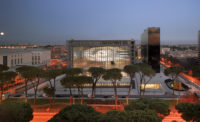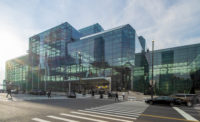Rome's Convention Center by Studio Fuksas Transformed Into Covid-19 Vaccination Hub

Photo © Marco Delogu

Photo © Marco Delogu

Photo © Marco Delogu

Photo © Leonardio Finotti

Photo © Moreno Maggi

Photo © Moreno Maggi

Photo © Leonardio Finotti

Photo © Moreno Maggi








Opened in 2016, the New Rome-EUR Convention Center by Massimiliano and Doriana Fuksas of Studio Fuksas was an early victim of COVID-19, which required canceling the conventions, operas, ballets and other public gatherings held in the monumental building. One of Rome’s proudest contemporary structures--and the largest completed in the city in 50 years–went dark. The glass-and-steel hangar, which garages an auditorium enveloped by a translucent white fiberglass cloud made feasible with 3D software, updated the residential and business district EUR – the surrounding Modernist, largely masonry interwar area of Rome – by an era.
Ironically, it was COVID that re-opened the structure on February 24 in its new, temporary role as the largest vaccination center in Italy (and perhaps Europe). The President of the Italian Republic, Sergio Mattarella, along with a large cohort of local and regional officials, celebrated the event—cameras rolling—by visiting on March 6. Italy has been one of the countries in Europe most traumatized by the virus, and the high architectural profile of such a prominent building signaled the seriousness of the government’s response to the threat, and the collective determination at all levels of the state. The city and country enlisted one of the best and brightest buildings of the times to the cause.
Since reopening, about 3,500 people a day have been streaming down the rolling sidewalk and adjacent ramped staircase to receive their AstraZeneca and Pfizer shots, among others, in the concourse on the lower floor. Coming from all parts of Rome—and beyond— by subway as well as car, many of the visitors have never seen the building. Its state-of-the-art, double-glazed truss-framed walls and roof, not to mention the futuristic, strangely beautiful Nuvola inside (“cloud,” in Italian), provide a reassuring technological environment for the life-saving technology delivered through a needle. High-tech vaccine meets high-tech architecture in a choreography of matched equals.
When it comes to COVID vaccination centers, size matters, and the 107,639-square-foot concourse on the lower floor has the scale requisite for handling an industrial operation with thousands of patients filing through, as though on a conveyor belt, with two meters of separation. The floor area accommodates the long lines, a waiting room, triage areas, the vast space for delivering the vaccines, the post-vaccine waiting hall, and an area for issuing certificates of vaccination. The open, column-free spaces facilitate clear organization.
Doriana Fuksas notes that unlike many vaccination hubs improvised within schools and gyms, the convention center is open and pleasant, its tall ceilings and glass walls allowing sunlight in, and views out to the sky and to Rome’s pines. “It’s quite moving to see the environmental respect the building offers to people undergoing a medical procedure during very stressful times,” says Ms. Fuksas. “We are very proud that a building we designed for one kind of use is flexible enough to handle other uses.”
Massimiliano Fuksas measures the success of a building by such flexibility, and he relates this episode in the life of the convention center to Rome’s long architectural history. The first century AD Theater of Marcellus was, he says, “built as a theater, and then it served as a quarry before becoming a fortress, and then a palace, and now a community of houses and apartments. A building makes sense if it is flexible.”
By the yardstick of its successful conversion into a vaccination hub, the Convention Center has many lives ahead of it in the coming millennia of Rome’s ongoing architectural timeline.



